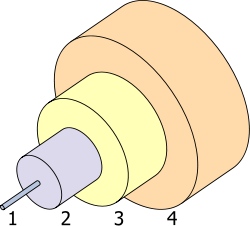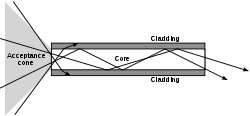
Core (optical fiber)
Encyclopedia


Optical fiber
An optical fiber is a flexible, transparent fiber made of a pure glass not much wider than a human hair. It functions as a waveguide, or "light pipe", to transmit light between the two ends of the fiber. The field of applied science and engineering concerned with the design and application of...
is a cylinder of glass
Glass
Glass is an amorphous solid material. Glasses are typically brittle and optically transparent.The most familiar type of glass, used for centuries in windows and drinking vessels, is soda-lime glass, composed of about 75% silica plus Na2O, CaO, and several minor additives...
or plastic
Plastic
A plastic material is any of a wide range of synthetic or semi-synthetic organic solids used in the manufacture of industrial products. Plastics are typically polymers of high molecular mass, and may contain other substances to improve performance and/or reduce production costs...
that runs along the fiber's length. The core is surrounded by a medium with a lower index of refraction, typically a cladding
Cladding (fiber optics)
Cladding is one or more layers of material of lower refractive index, in intimate contact with a core material of higher refractive index. The cladding causes light to be confined to the core of the fiber by total internal reflection at the boundary between the two. Light propagation in the...
of a different glass, or plastic. Light travelling in the core reflects from the core-cladding boundary due to total internal reflection
Total internal reflection
Total internal reflection is an optical phenomenon that happens when a ray of light strikes a medium boundary at an angle larger than a particular critical angle with respect to the normal to the surface. If the refractive index is lower on the other side of the boundary and the incident angle is...
, as long as the angle between the light and the boundary is less than the critical angle
Critical angle
Critical angle can refer to:*Critical angle the angle of incidence above which total internal reflection occurs*Critical angle of attack, in aerodynamics; the angle of attack which produces the maximum lift coefficient...
. As a result, the fiber transmits all ray
Ray (optics)
In optics, a ray is an idealized narrow beam of light. Rays are used to model the propagation of light through an optical system, by dividing the real light field up into discrete rays that can be computationally propagated through the system by the techniques of ray tracing. This allows even very...
s that enter the fiber with a sufficiently small angle to the fiber's axis. The limiting angle is called the acceptance angle, and the rays that are confined by the core/cladding boundary are called guided rays.
The core is characterized by its diameter
Diameter
In geometry, a diameter of a circle is any straight line segment that passes through the center of the circle and whose endpoints are on the circle. The diameters are the longest chords of the circle...
or cross-sectional
Cross section (geometry)
In geometry, a cross-section is the intersection of a figure in 2-dimensional space with a line, or of a body in 3-dimensional space with a plane, etc...
area. In most cases the core's cross-section should be circular, but the diameter is more rigorously defined as the average of the diameters of the smallest circle that can be circumscribed about the core-cladding boundary, and the largest circle that can be inscribed within the core-cladding boundary. This allows for deviations from circularity due to manufacturing variation.
Another commonly-quoted statistic for core size is the mode field diameter
Mode field diameter
In fiber optics, the mode field diameter is an expression of distribution of the irradiance, i.e., the optical power per unit area, across the end face of a single-mode fiber.For a Gaussian intensity In fiber optics, the mode field diameter (MFD) is an expression of distribution of the irradiance,...
. This is the diameter at which the intensity
Intensity (physics)
In physics, intensity is a measure of the energy flux, averaged over the period of the wave. The word "intensity" here is not synonymous with "strength", "amplitude", or "level", as it sometimes is in colloquial speech...
of light in the fiber falls to some specified fraction of maximum (usually 1/e2≈13.5%). For single-mode fiber, the mode field diameter is larger than the physical diameter of the core, because the light penetrates slightly into the cladding as an evanescent wave
Evanescent wave
An evanescent wave is a nearfield standing wave with an intensity that exhibits exponential decay with distance from the boundary at which the wave was formed. Evanescent waves are a general property of wave-equations, and can in principle occur in any context to which a wave-equation applies...
.

